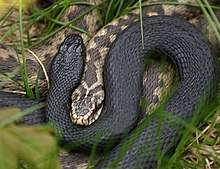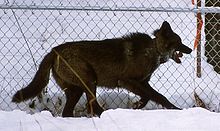Melanism



Melanism is a development of the dark-colored pigment melanin in the skin or its appendages and is the opposite of albinism. Historically, it was also the medical term for black jaundice.[2]
The word melanism is derived from the Greek: μελανός ("black pigment").[3]
Pseudo-melanism, also called abundism, is another variant of pigmentation, characterized by dark spots or enlarged stripes, which cover a large part of the body of the animal, making it appear melanistic.[4] A deficiency in or total absence of melanin pigments is called amelanism.
The morbid deposition of black matter, often of a malignant character causing pigmented tumors, is called melanosis.[5] For a description of melanin-related disorders, see melanin, melanosis coli and ocular melanosis.
Adaptation

Melanism related to the process of adaptation is called adaptive. Most commonly, dark individuals become fitter to survive and reproduce in their environment as they are better camouflaged. This makes some species less conspicuous to predators, while others, such as black panthers, use it as a foraging advantage during night hunting.[6] Typically, adaptive melanism is heritable: A dominant gene, which is entirely or nearly entirely expressed in the phenotype, is responsible for the excessive amount of melanin.
Adaptive melanism has been shown to occur in a variety of animals, including mammals such as squirrels, many felines and canids, and coral snakes. Adaptive melanism can lead to the creation of morphs, the most notable example being the peppered moth, whose evolutionary history in the United Kingdom is offered as a classic instructional tool for teaching the principles of natural selection.[7]
Industrial melanism
Industrial melanism is an evolutionary effect in insects such as the peppered moth, Biston betularia in areas subject to industrial pollution. Darker pigmented individuals are favored by natural selection, apparently because they are better camouflaged against polluted backgrounds. When pollution was later reduced, lighter forms regained the advantage and melanism became less frequent.[8][9][10][11][12][13] Other explanations have been proposed, such as that the melanin pigment contributes to the destruction of invaders through the immune defences of the dark-colored form of the organism.[14] Another proposed mechanism is that there is a thermal advantage from the darker coloration.[15][15] [16][17]
In felines
Melanistic coat coloration occurs as a common polymorphism in 11 of 37 felid species and reaches high population frequency in some cases but never achieves complete fixation. The black panther, a melanic form of leopard, is common in the equatorial rainforest of Malaya and the tropical rainforest on the slopes of some African mountains, such as Mount Kenya. The serval also has melanic forms in certain areas of East Africa. In the jaguarundi, coloration varies from dark brown and gray to light reddish. Melanic forms of jaguar are common in certain parts of South America.[18] In 1938 and 1940, two melanistic bobcats were trapped alive in sub-tropical Florida.[19]
In 2003, the dominant mode of inheritance of melanism in jaguars was confirmed by performing phenotype-transmission analysis in a 116-individual captive pedigree. Melanistic animals were found to carry at least one copy of a mutant MC1R sequence allele, bearing a 15-base pair inframe deletion. Ten unrelated melanistic jaguars were either homozygous or heterozygous for this allele. A 24-base pair deletion causes the incompletely dominant allele for melanism in the jaguarundi. Sequencing of the agouti signalling peptide in the agouti gene coding region revealed a 2-base pair deletion in black domestic cats. These variants were absent in melanistic individuals of Geoffroy’s cat, oncilla, pampas cat and Asian golden cat, suggesting that melanism arose independently at least four times in the cat family.[20]
Melanism in leopards is inherited as a Mendelian, monogenic recessive trait relative to the spotted form. Pairings of black animals have a significantly smaller litter size than other possible pairings.[21] Between January 1996 and March 2009, leopards were photographed at sixteen sites in the Malay Peninsula in a sampling effort of more than 1000 trap nights. Of 445 photographs of melanistic leopards taken, 410 came from study sites south of the Kra Isthmus, where the non-melanistic morph was never photographed. These data suggest the near fixation of the dark allele in the region. The expected time to fixation of this recessive allele due to genetic drift alone ranged from about 1,100 years to about 100,000 years.[22] Melanism in leopards has been hypothesized to be causally associated with a selective advantage for ambush.[23]
Melanism is widespread in domestic cats, and has a cultural significance among human societies as black cats are the focus of many superstitions, legends and religious beliefs.
In birds
In April 2015, an extremely rare black flamingo was spotted on the Mediterranean island of Cyprus.[24] The Silkie chicken exhibits this trait.
Immune system

Melanin has several physiological roles in maintaining health, such as the synthesis of vitamin D. Melanin is the primary determinant of the degree of skin pigmentation and protects the body from harmful ultraviolet radiation. Synthesis of 1,25-dihydroxyvitamin D3 in the skin, however, is dependent on ultraviolet B light. Highly pigmented skin, to the level found in people of African origin, abrogates almost all ultraviolet-induced 1,25-(OH)2D3 synthesis. Numerous animal models and clinical studies have underlined the essential role of vitamin D as a modulator of the different processes of the immune system. Evidence indicates that serum concentrations of 1,25-(OH)2D3 and the prevalence of autoimmune diseases in a certain population are associated with the latitude at which that population resides.[25]
Genes for melanism in felines may provide resistance to viral infections. A viral epidemic may explain the prevalence of black leopards in Java and Malaysia and the relatively high incidence of black leopards and black servals in the Aberdares region of Africa. Previously, black-furred felines in the Aberdares had been considered a high-altitude adaptation, since black fur absorbs more heat.[26]
Studies reported in New Scientist magazine in 2003 also suggested that recessive-gene melanism is linked to disease resistance rather than altitude. Melanistic cats may have better resistance to disease than cats with "normal" color coats. This would explain why recessive melanism persists when melanistic individuals are disadvantaged because they are poorly camouflaged in open areas.
Socio-politics
The term melanism has been used on Usenet, internet forums and blogs to mean an African-American social movement holding that dark-skinned humans are the original people from which those of other skin colour originate. The term melanism has been used in this context as early as the mid-1990s[27] and was promoted by some Afrocentrists, such as Frances Cress Welsing.
See also
- Albinism
- Albino and white squirrels
- Amelanism
- Black cat
- Erythrism
- Heterochromia iridum
- Leucism
- Piebaldism
- Vitiligo
- Xanthochromism
References
- ^ Morales, E. (1995). The Guinea Pig : Healing, Food, and Ritual in the Andes. University of Arizona Press. ISBN 0-8165-1558-1.
- ^ Webster's Revised Unabridged Dictionary (1913) Melanism. C. & G. Merriam Co. Springfield, Massachusetts. Page 910
- ^ Liddell, H. G., Scott, R. (1940). μελα^νός. In: A Greek-English Lexicon, revised and augmented throughout by Sir Henry Stuart Jones, with the assistance of Roderick McKenzie. Clarendon Press, Oxford.
- ^ Osinga, N., Hart, P., van VoorstVaader, P. C. (2010). Albinistic common seals (Phoca vitulina) and melanistic grey seals (Halichoerus grypus) rehabilitated in the Netherlands. Animal Biology 60 (3): 273−281.
- ^ Webster's Revised Unabridged Dictionary (1913) Melanosis. C. & G. Merriam Co. Springfield, Massachusetts. Page 910
- ^ King, R.C., Stansfield, W.D., Mulligan, P.K. (2006). A Dictionary of Genetics, 7th ed., Oxford University Press
- ^ Begon, M., Townsend, C. R., Harper, J. L. (2006). Ecology: From individuals to ecosystems. 4th ed., Blackwell Publishing Malden, Oxford, Victoria.
- ^ Majerus, M. E. (2009). Industrial melanism in the peppered moth, Biston betularia: an excellent teaching example of Darwinian evolution in action. Evolution: Education and Outreach, 2(1), 63-74.
- ^ McIntyre, N. E. (2000). Ecology of urban arthropods: a review and a call to action. Annals of the Entomological Society of America, 93(4), 825-835.
- ^ Cook, L. M., Saccheri, I. J., 2013. The peppered moth and industrial melanism: evolution of a natural selection case study. Journal of Heredity 110:207-12
- ^ Grant, B. S., Wiseman L. L., 2002. Recent history of melanism in american peppered moths. Journal of Heredity 93:86-90.
- ^ Brakefield, P. M., Liebert, T. G., 2000. Evolutionary dynamics of declining melanism in the peppered moth in the Netherlands. Proceedings of the Royal Society of London Biology 267:1953-1957.
- ^ Grant, B. S., Cook, A. D., Clarke, C. A., & Owen, D. F. (1998). Geographic and temporal variation in the incidence of melanism in peppered moth populations in America and Britain. Journal of Heredity, 89(5), 465-471.
- ^ Mikkola, K., & Rantala, M. J. (2010). Immune defence, a possible nonvisual selective factor behind the industrial melanism of moths (Lepidoptera). Biological Journal of the Linnean Society, 99(4), 831-838.
- ^ a b Mikkola, K., Albrecht, A., 1988. The melanism of Adalia-bipunctata around the Gulf of Finland as an industrial phenomenon (Coleoptera, Coccinellidae). Annales Zoologici Fennici 25:177-85.
- ^ Muggleton, J., Lonsdale, D., Benham, B. R., 1975. Melanism in Adalia-bipunctata L (ColCoccinellidae) and its relationship to atmospheric pollution. Journal of Applied Ecology 2:451-464.
- ^ De Jong, P. W., Verhoog, M. D., Brakefield, P. M., 1992. Sperm competition and melanic polymorphism in the 2-spot ladybird, Adalla bipunctata (Coleoptera, Coccinellidae). Journal of Heredity 70:172-178.
- ^ Searle, A. G. (1968) Comparative Genetics of Coat Colour in Mammals. Logos Press, London
- ^ Ulmer, F. A. (1941) Melanism in the Felidae, with special reference to the Genus Lynx. Journal of Mammalogy 22 (3): 285–288.
- ^ Eizirik, E., Yuhki, N., Johnson, W. E., Menotti-Raymond, M., Hannah, S. S., O'Brien, S. J. (2003). "Molecular Genetics and Evolution of Melanism in the Cat Family" (PDF). Current Biology. 13 (5): 448–453. doi:10.1016/S0960-9822(03)00128-3. PMID 12620197.
{{cite journal}}: CS1 maint: multiple names: authors list (link) - ^ Robinson, R. (1970). "Inheritance of black form of the leopard Panthera pardus". Genetica. 41: 190–197. doi:10.1007/BF00958904. PMID 5480762.
- ^ Kawanishi, K., Sunquist, M. E., Eizirik, E., Lynam, A. J., Ngoprasert, D., Wan Shahruddin, W. N., Rayan, D. M., Sharma, D. S. K., Steinmetz, R. (2010) Near fixation of melanism in leopards of the Malay Peninsula. Journal of Zoology, Volume 282 (3): 201–206.
- ^ Majerus, M. E. N. (1998) Melanism: evolution in action. Oxford University Press, New York
- ^ Krol, Charlotte (2015-04-09). "Rare black flamingo spotted in Cyprus". The Telegraph. Archived from the original on 2015-04-25. Retrieved 2015-05-16.
{{cite news}}: Unknown parameter|deadurl=ignored (|url-status=suggested) (help) - ^ Shoenfeld, N., Amital, H., Shoenfeld, Y. (2009). The effect of melanism and vitamin D synthesis on the incidence of autoimmune disease. Nature Reviews Rheumatology 5: 99−105.
- ^ Seidensticker, J., Lumpkin, S. (2006). Smithsonian Q & A: the ultimate question and answer book. Cats. Collins, New York
- ^ "Sundiata, AFROCENTRISM: THE ARGUMENT WE'RE REALLY HAVING". Retrieved 2007-06-23.
Bibliography
- David Attenborough (2002). The Life of Mammals (TV-Series and book). United Kingdom: BBC.
- Kettlewell, Bernard (1973). The Evolution of Melanism. Clarendon Press. ISBN 0-19-857370-7.
- Majerus, Michael (1998). Melanism: Evolution in Action. Oxford University Press. ISBN 0-19-854982-2.
- Melanism and disease resistance in insects
- Fryer, G. 2013. How should the history of industrial melanism in moths be interpreted? The Linnean. 29 (2): 15 - 22.
